Women in workplace in Bangladesh
Aspiring to make strides towards advancement despite obstacles
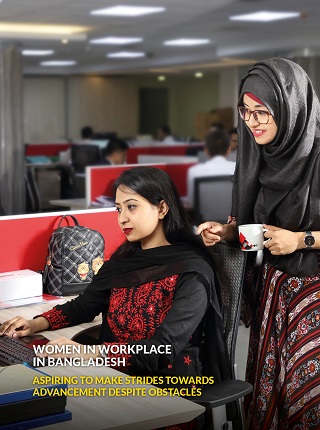
Worldwide, the participation of women in workplace has been appreciated over the last four decades, and the scenario has been improved significantly in last few years. Many companies are committed to bring about gender diversity in the workplace as they initiated specialized programs. The trend is also on the rise in Bangladesh. Many women have climbed up the career ladder to top leadership positions of reputed organizations while others have found their dreams in their ventures. The number of females in top leadership position is not substantial but it can be considered as a good start as more women are engaging themselves to pursue a career. However, this is not enough taking the significant number of working-age women population into consideration, who have valuable contribution in the economy.
Even as globalization has brought millions of women into paid labour than ever, the number of women in the workforce is far behind than that of men. Gender inequalities have also concentrated women at the bottom of the global value chain in the lowest paid jobs, in piece-rate, subcontracted work, and insecure forms of self-employment, with little or no access to decent work and social protection. Women represent half the world’s potential; working-age population in the global workforce comprise of 49.6% women. The economics make sense too: if women played an identical role in labour markets to that of men, as much as USD 28 trillion, or 26% could be added to the global annual Gross Domestic Product by 2025.
The increasing involvement of women in informal economy or grey economy is alarming. In Southeast Asia, informal women employment reflects 95% of total women employment. Informal work include those who are self-employed- such as street vendors, petty goods traders and subsistence farmers- as well as waged workers in domestic or seasonal agricultural work. One of the most vulnerable forms of informal employment is contributing family work. Globally, women comprise 63% of these workers, who are employed without direct pay in family businesses or farms. Informal economy falls out of the purview of labour laws, leaving many exposed to low pay and unsafe working conditions, and without social benefits, such as pensions, sick pay and health insurance. In Bangladesh, informal women employment makes up 89% of total women employment.
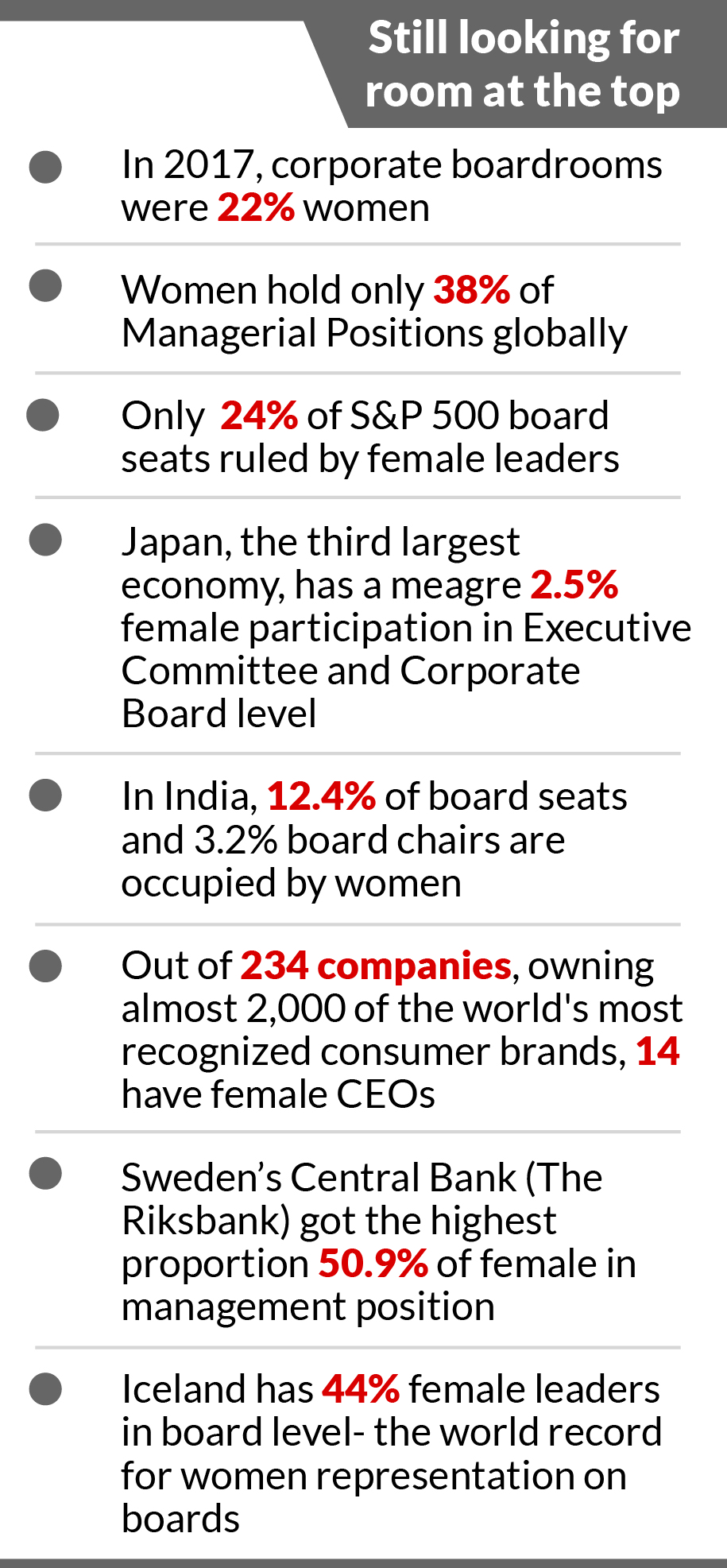
Women are hard to find at the top echelons in global financial sector
“If women ran the world, there would be no wars.” It is an old stereotype, but there is something to be said for the effects of more women in leadership positions. Financial Institutions (FI) have been employers of women for decades: historically as tellers, bookkeepers, secretaries, and junior administrative staff. In the 1980s, however, pioneering women began moving into management roles and into frontline business areas, such as investment banking. Despite the observed benefits, however, company leadership around the world remains unbalanced, with women accounting for less than a quarter of management positions globally. The disparity is even greater when it comes to higher-level management positions. Women are far more likely than men to leave the industry or to reduce their level of ambition just at the point in their careers when they need to make the effort to push on to the top. This comes as a surprise to the many younger women entering the profession, who see such low participation of women at the top and become doubtful if she can ever reach the leadership role.
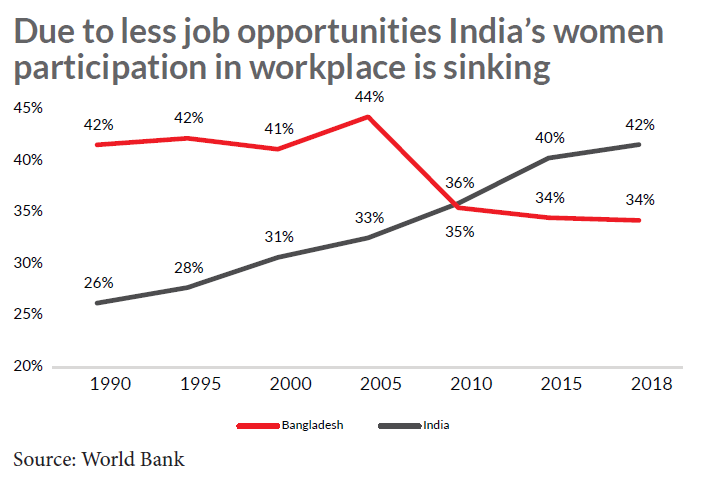
Women marching forward in workplace: Bangladesh perspective
Women’s participation in the labour force increased manifolds over time in Bangladesh. Female participation in the labour force has increased to 35.6% in 2016, from a meagre 4% in 1974. Although, the number is much low compared to that of male labor force participation, the growth is much higher. Interestingly, labour force participation among rural women exceeds (37.6%) than urban women (30.8%). Not only in the export oriented readymade garments sector but in many non-traditional and emerging sectors, such as hotels and restaurants, transportation, real estate services, telecommunications, banking and insurance sectors, women’s participation is increasing. The phenomenon ascribes to increased access to higher education, accounting for which the prospect for getting into high valued job market has expanded for women in Bangladesh.
According to International Labor (ILO) Organization, the total number of women in workplace was 18.1 million in 2017. According to official statistics, though on average women earn about 94% of what men earn, it varies across sectors. The low share of women’s incomes compared to men’s on average is partly due to women’s involvement in the informal sector to a greater extent.
A number of factors act as barriers for higher participation of women in the labour force. Lack of infrastructure, for instance, lack of transport, toilet, child care facility and overall security hinder them to take part in the job market. Apart from these and the ever-existent societal challenges, technological upgradation in many sectors has taken away more jobs from women than from men. For example, the largest sector for female employment is the RMG factories where female participation was almost 80% of all RMG workers. Unfortunately, female participation in this sector has now decelerated to about 61%, thanks to the automation in the sector, according to a Centre for Policy Dialogue (CPD) survey.
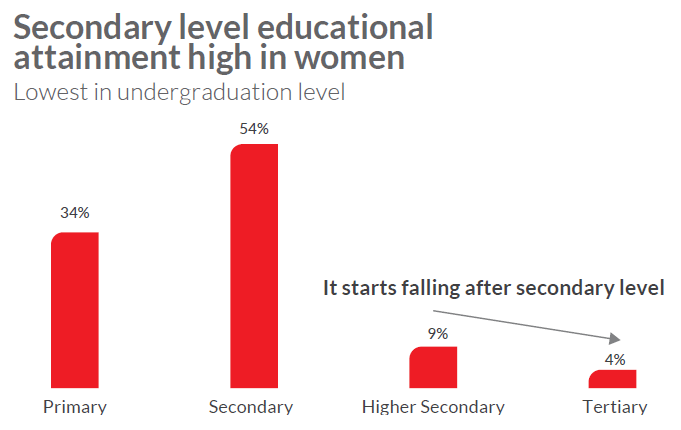
Top Management are only 5.2% women in local financial sector
The financial sector has always been considered as the best place for women to work in, although in entry positions. However, the women employment rate in Bangladesh banking sector went down to 12.23% in 2018 from 13.73% in 2016. The ratio of female executives occupying higher ranks in the sector is also negligible, according to a study by Bangladesh Institute of Bank Management (BIBM).
Few reasons ascribe to this phenomenon. Because of the reproductive role, many women are forced to choose between motherhood and careers. A large number of promising young university graduates enter the job market. However, the enthusiasm starts to decline over time due to family responsibilities. This mid-way drop-out of female employees reduces the number of potential women in senior positions.
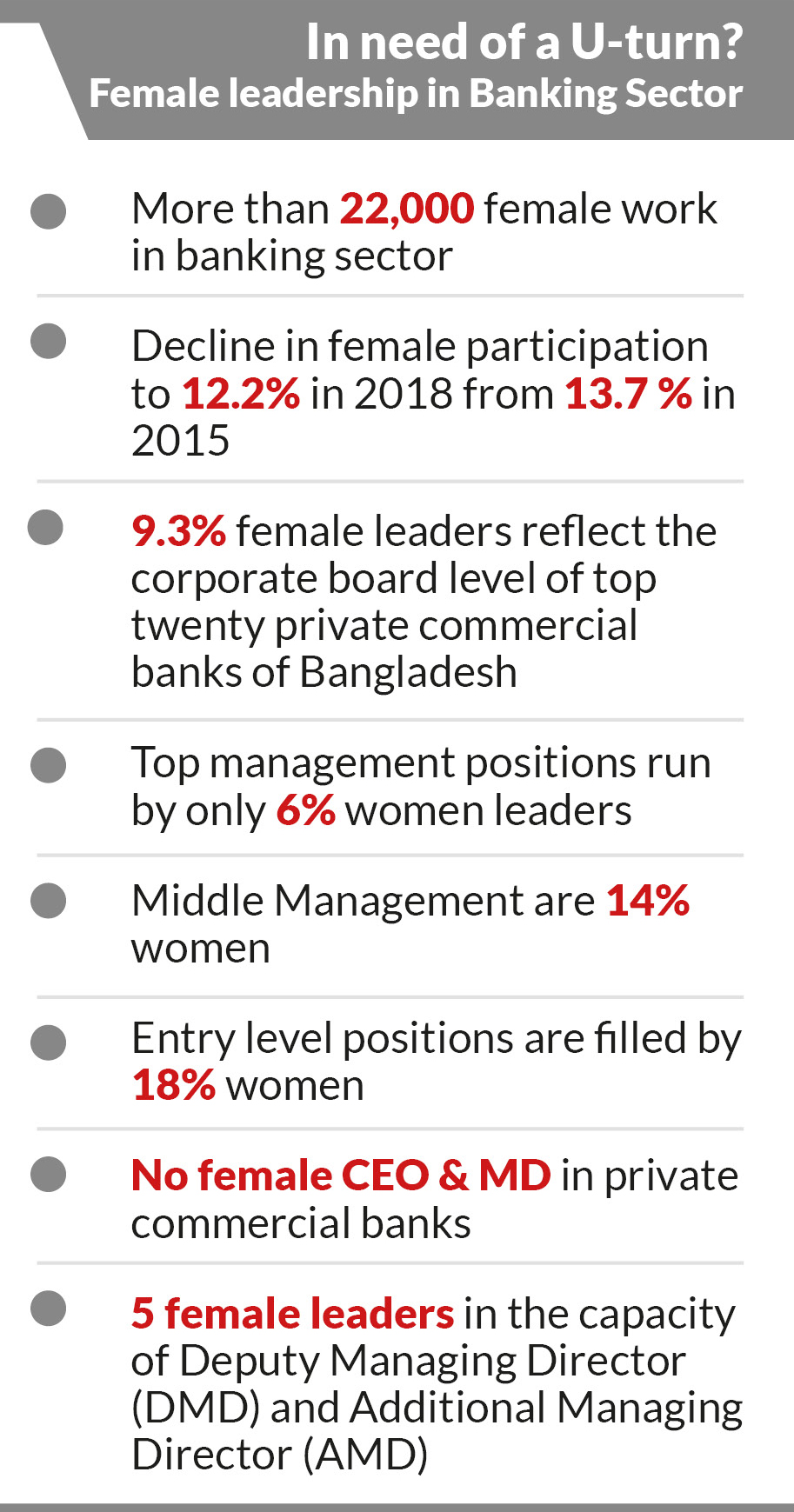
Women-led SME Businesses: The changing landscape
Out of the 35.6% women participation in total labour force, only 12% has emerged as entrepreneurs. An estimated 0.43 million women entrepreneurs own and operate businesses accounting for 5.9% of the total entrepreneurs in the country. Although, the numbers does not justify the immense and unleashed potential of the half of the total workforce, there has been a tangible change in the way women do their business.
80% of the business are managed by women entrepreneurs, according to a recent survey on 1510 women-headed enterprises by Bangladesh Institute of Development Studies (BIDS). In earlier times, most of the women-led businesses were actually run by their spouses or any other male family member. The statistics implies that this is a major behavioral shift in women entrepreneurship, which is driven by education.
According to the same survey, more women, having a graduation degree are setting up their own venture instead of going for a formal job. The share of such business women increased to 27% in 2017 from 20% in 2009. The increasing female drop-out rate after a certain position in formal workplace, explains this behavior. Many women who are forced to leave their job due to fulfillment of family responsibilities, seek for financial empowerment by establishing a venture.
Motivating factors shifted from meeting family requirements to empowering herself. In the same survey 29% women business-owners admitted that they are mostly driven by the factor of being self-reliant while running the enterprise, whereas 25% women emphasized on meeting family necessities. However, there was a U-turn in motivating factors in 2009, 48% of the women business owners were working just to meet family needs.
More reliance on institutional credit sources than personal funding. 25% of the surveyed women business owners availed credit from banks, whereas it was 7% in 2009. Few policy-level initiatives like single digit lending rate, refinance scheme for women-led businesses explain this phenomenon. However, the challenges of availing credit from banks are still the same:
![]() Arranging guarantors and their documents in getting a loan
Arranging guarantors and their documents in getting a loan
![]() Banks asking for mortgage documents
Banks asking for mortgage documents
![]() Lengthy application form
Lengthy application form
![]() High-interest rate and demand for transaction in a bank account
High-interest rate and demand for transaction in a bank account
![]() Lack of proper information regarding the rules of loans in different banks
Lack of proper information regarding the rules of loans in different banks
![]() Higher Service Charge
Higher Service Charge
![]() Lack of proper knowledge regarding the banking system
Lack of proper knowledge regarding the banking system
![]() Difficulties in availing loan for widows or divorced women
Difficulties in availing loan for widows or divorced women
Purnota - A comprehensive package for women entrepreneur by IDLC

‘Purnota’- the meaning of this Bengali word is entirety of something. Carrying much significance with its literal meaning, Purnota - the Women Entrepreneur Loan (WEL) product offers a comprehensive package for the women business owners to take their ventures to the next level. Not only the product offers loan facility with lower interest rate, it also facilitates the women in obtaining regulatory documents and license essential to conduct a business. Furthermore, Purnota Club is established with a view to capacity and skill development of the women, business management and vocational training.
How Financial Institutions are enabling women in the workplace
Globally, most financial firms are genuinely committed to improving gender balance among their senior executives. To that end, they have introduced a number of “women-friendly” programs, such as flexible hours, parental leave, and mentorship schemes.
![]() Maternity Leave: In Bangladesh, banks and FIs provide the facility of mandatory 6-months of maternity leave to all women employees as part of the policy requirement.
Maternity Leave: In Bangladesh, banks and FIs provide the facility of mandatory 6-months of maternity leave to all women employees as part of the policy requirement.
![]() Transportation Facility: Currently, 26 banks have their own transport facilities in order to provide safe commute to their female employees.
Transportation Facility: Currently, 26 banks have their own transport facilities in order to provide safe commute to their female employees.
![]() Daycare Center: Lack of daycare centers seems to be a major issue that many working ladies are forced to leave their promising career after giving birth to their child. With no actual estimate on the total number of daycare facilities, the number of such centers is meagre. State-run banks opened a daycare center at Motijheel for their employees in 2015. Later, 21 private banks opened another for their employees in the same area. BRAC Bank Limited has their own in-house day-care center to facilitate the working-mothers, although the facility is only confined for female employees working at HeadOffice.
Daycare Center: Lack of daycare centers seems to be a major issue that many working ladies are forced to leave their promising career after giving birth to their child. With no actual estimate on the total number of daycare facilities, the number of such centers is meagre. State-run banks opened a daycare center at Motijheel for their employees in 2015. Later, 21 private banks opened another for their employees in the same area. BRAC Bank Limited has their own in-house day-care center to facilitate the working-mothers, although the facility is only confined for female employees working at HeadOffice.
![]() Development of Women’s Forum: Many banks now have a Women Entrepreneurs Development Unit especially focusing on the economic development of the female employees. There are women’s forums that work to empower women to establish their rights and resolve issues. BRAC Bank Tara and IDLC ladies forum are well-known women forums among FIs. Apart from these, many other groups not initiated by FIs are creating impact for the empowerment of women. Also, FIs are now arranging a variety of awareness sessions for their female employees.
Development of Women’s Forum: Many banks now have a Women Entrepreneurs Development Unit especially focusing on the economic development of the female employees. There are women’s forums that work to empower women to establish their rights and resolve issues. BRAC Bank Tara and IDLC ladies forum are well-known women forums among FIs. Apart from these, many other groups not initiated by FIs are creating impact for the empowerment of women. Also, FIs are now arranging a variety of awareness sessions for their female employees.
Financial Institutions in creation of female entrepreneurs
Having realized the significance and potential of women entrepreneurship, FIs came up with few extra initiatives for their women entrepreneur customers, other than just providing funding facilities.
![]() Specialized Finance Products: Most of the Banks and Non-Bank Financial Institutions (NBFIs) have already launched some special plans and offerings for the female entrepreneurs in order to make them economically strong and financially independent. Under these schemes, SME women entrepreneurs are entitled to avail collateral-free funding upto BDT 2.5 million (if eligible) at an interest rate not more than 10%.
Specialized Finance Products: Most of the Banks and Non-Bank Financial Institutions (NBFIs) have already launched some special plans and offerings for the female entrepreneurs in order to make them economically strong and financially independent. Under these schemes, SME women entrepreneurs are entitled to avail collateral-free funding upto BDT 2.5 million (if eligible) at an interest rate not more than 10%.
![]() Training and Workshop: FIs organize training programs for their SME women entrepreneurs in order to make them efficiently run their business. Under the “TARA” platform, BRAC Bank is arranging capacity building training sessions on “Media Marketing” to “Networking Capacity Development”, through which women entrepreneurs are able to learn about the essentials directly related to their business. Eastern Bank Limited (EBL) signed an MoU with Bangladesh Woman Chamber of Commerce and Industries (BWCCI) to provide credit facilities to the trained women under SEIP project at lower interest rate and easy loan process. Mutual Trust Bank Limited also organizes many display fairs and training programs for women entrepreneurs. IDLC Finance Limited, under “Purnota (Women Entrepreneur Loan Product)” platform, arranges various training programs in collaboration with SME Foundation for the women entrepreneurs catering to rural areas.
Training and Workshop: FIs organize training programs for their SME women entrepreneurs in order to make them efficiently run their business. Under the “TARA” platform, BRAC Bank is arranging capacity building training sessions on “Media Marketing” to “Networking Capacity Development”, through which women entrepreneurs are able to learn about the essentials directly related to their business. Eastern Bank Limited (EBL) signed an MoU with Bangladesh Woman Chamber of Commerce and Industries (BWCCI) to provide credit facilities to the trained women under SEIP project at lower interest rate and easy loan process. Mutual Trust Bank Limited also organizes many display fairs and training programs for women entrepreneurs. IDLC Finance Limited, under “Purnota (Women Entrepreneur Loan Product)” platform, arranges various training programs in collaboration with SME Foundation for the women entrepreneurs catering to rural areas.
Apart from these, FIs are facilitating the women savers by providing them with higher deposit rates. There are some other initiatives worth to mention that draw the women savers/borrowers to come under the banking net. AB Bank Limited signed an agreement with MetLife to provide life insurance coverage for its Shampurna Women’s Savings account holders. Under this arrangement, MetLife Bangladesh will assure the account holders with life and health insurance protection. EBL Women Banking is offering BDT 2 million unsecured loans to women executives and professionals.
Central Bank ensuring women's strong footprint in the banking arena
In a bid to ensure the right and security of female employees, Central Bank instructed the state-owned banks and private commercial banks to facilitate the female employees with 6-months long full paid maternity leave. Alongside, according to Central Bank’s instruction, female employees of FIs are not bound to stay after the regular office hours, even if they have to stay for some urgent work, the employer (FI) has to arrange for transportation for them.
In order to accelerate female entrepreneurship, Central Bank undertook following policy-driven actions:
![]() To ensure balanced industrial development, a minimum 15% of total SME Funds have been allocated for women entrepreneurs in the SME sector
To ensure balanced industrial development, a minimum 15% of total SME Funds have been allocated for women entrepreneurs in the SME sector
![]() The applicable interest rate of the credit for women entrepreneurs will be Bank rate (which is at present 5%) plus maximum 5%; not more than 10%
The applicable interest rate of the credit for women entrepreneurs will be Bank rate (which is at present 5%) plus maximum 5%; not more than 10%
![]() Banks/Financial Institutions will accept and settle all types of loan applications of women entrepreneurs in SME sector with high priority
Banks/Financial Institutions will accept and settle all types of loan applications of women entrepreneurs in SME sector with high priority
![]() Banks and financial institutions shall take initiative to advertise all the facilities for women entrepreneurs in both electronic & print media
Banks and financial institutions shall take initiative to advertise all the facilities for women entrepreneurs in both electronic & print media
![]() Banks and Financial Institutions can provide a maximum loan facility of Tk.2.5 million against personal guarantee if borrower is woman or maximum share of the enterprise held by woman
Banks and Financial Institutions can provide a maximum loan facility of Tk.2.5 million against personal guarantee if borrower is woman or maximum share of the enterprise held by woman
![]() Banks/Financial Institutions shall establish special advice and service centre for women entrepreneurs in selected branches; ensure service friendly approach towards women entrepreneurs.
Banks/Financial Institutions shall establish special advice and service centre for women entrepreneurs in selected branches; ensure service friendly approach towards women entrepreneurs.
Alongside these policy-driven initiatives, Central Bank arranges a SME Women Entrepreneur Fair every year on the occasion of International Women’s Day where women clients of every bank can showcase their products, create networking and get recognized.
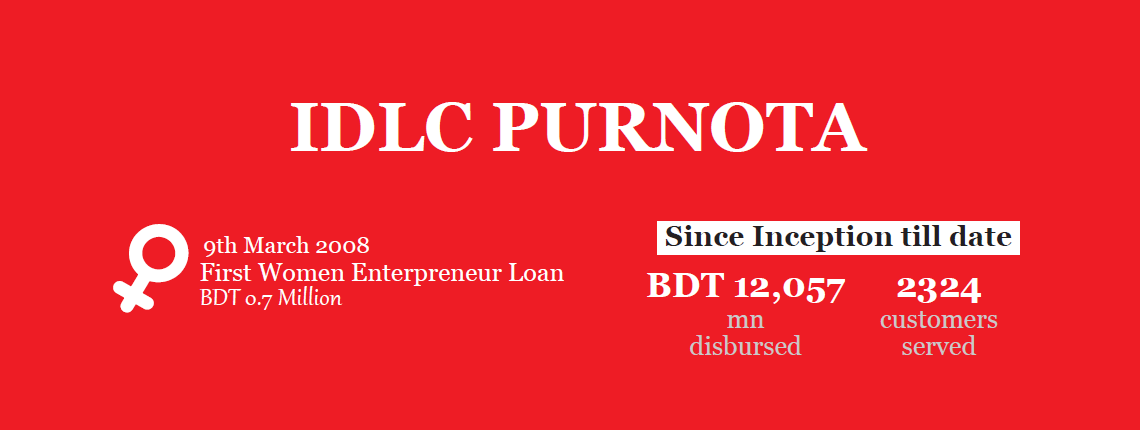
Framework to ensure better representation of women
 Initiating “Mentorship Program”
Initiating “Mentorship Program”
According to Annual Corporate Directors Survey 2018, nearly 95% of directors in corporate level agree that diversity brings unique perspectives to the boardroom, while 84% believe it enhances board performance. Holding on to that viewpoint, FIs can identify the leadership qualities in young women professional at entry-level and initiate mentorship program for them so that they can groom themselves from nascent stage and reach top leadership positions eventually.
 Stalling the “mid-level drop out” rate by ensuring facilities
Stalling the “mid-level drop out” rate by ensuring facilities
A lot of corporate women professionals become bound to leave their jobs in mid-level due to fulfilling family responsibilities, primarily due to looking after their in lack of support. If FIs can collaborate together and create a common day-care facility for the working women, they can show higher productivity at work and at the same time, be loyal to the organization.
 Increasing the number of business facilitation services to rural women entrepreneurs
Increasing the number of business facilitation services to rural women entrepreneurs
FIs are already providing the rural women entrepreneurs with necessary trainings on non-financial services such as, how to maintain business accounts or on loan documentation. As the statistics reveals, rural women are engaging themselves more and more in entrepreneurial ventures and FIs need to increase the reach of these services in rural areas to a greater extent.
 Ensure gender equality policies
Ensure gender equality policies
In India, such policies are abundant and widespread, with 64% of Indian businesses adopting equal pay for men and women performing same roles, and 55% implementing non-discrimination policies for recruitment. Bangladesh can follow this and attract the larger chunk of female participants. Organizations must evaluate the gender distribution in their top management and develop a vision. This has to be followed by an analysis of how many potential women employees are currently in the middle rung of the organization to take up those available top slots over the next half decade.
 Changing mindset
Changing mindset
Lastly, societal mindset needs to be changed. Beyond the horizon of financial services, many women are reaching top in their respective fields; Bangladesh is proud to have her first female pilot, first female Everest Winner, a handful of female CEOs leading MNCs like Berger Paints Ltd, Microsoft Bangladesh and the like. Both in societal and corporate level, unless there is a change in the mindset in the top-tier people, female professionals and female business owners can never come out of their shell and prove their worth.

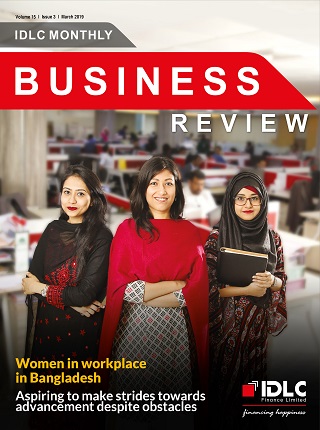
Monthly Business Review- March 2019
In the realm of global corporate leadership, one name resonates loudly across industries and regions: Indra Nooyi, the former CEO of PepsiCo. Hailing from the diversified India, Indra changed the face of PepsiCo when the brand was witnessing dwindling popularity. After she stepped down as the CEO after 24 glaring years in PepsiCo., market analysts are terming the position “very hard to replace” in wake of Indra’s bold and thoughtful leadership style.
This year, the theme for International Women’s Day is aptly kept- #BalanceforBetter. In Bangladesh, Ready Made Garments (RMG) has been the frontrunner in empowering females, where 4 million women found their earning source. Over the years, SME sector has also witnessed surge in active women entrepreneurs, who are highly motivated and aspired to take their business to a whole new level. The growing participation of young female entrepreneurs in F-commerce realm also deserves accolades. In corporate level, however, an unbalanced trend is discerned as we move up along with the hierarchy ladder. Female employees start falling out as they move to the mid-level in career and start having their own family responsibilities, resulting in a vacuum in top leadership positions. In many research and survey conducted internationally, it has been reflected that women make difference in the boardroom and in the company culture when they are put at helm of a company. It is high time, local corporates should recognize the fact and start working on the female potentials to the betterment of the company and coming up with suitable initiatives and facilities for them. Perhaps, down the line, Bangladesh may give birth to a number of Indra Nooyi’s who will change the face of the total economic scenario with their prudent leadership skills.
Download View